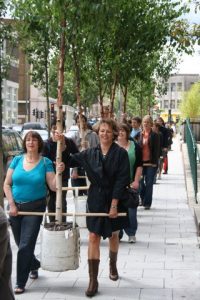 Congratulations to Whitelaw Turkington for sponsoring a landscape contribution to the London Festival of Architecture. A group of landscape architects marched through South London on Saturday 12th July 2008, carrying trees and with periodic pauses to consider the relationship between trees and London. Congratulations also, to one of the firm’s principals for becoming a tree bearer.
Congratulations to Whitelaw Turkington for sponsoring a landscape contribution to the London Festival of Architecture. A group of landscape architects marched through South London on Saturday 12th July 2008, carrying trees and with periodic pauses to consider the relationship between trees and London. Congratulations also, to one of the firm’s principals for becoming a tree bearer.
It is always good to see landscape architects on the march. But I wonder if they don’t need more political courage. Way back in 1983, I proposed to the then-chair of the Landscape Institute’s South East Chapter, that we should protest against the failure of the London Dockland Development Corporation (LDDC) to commission a Landscape Strategy. The proposal was that every landscape architect in London should keep their Christmas tree until it went brown. We would then carry the dead trees in procession from the Palace of Westminster to the HQ of the LDDC, cast them down and, should anyone be so brave, light a funeral pyre.
I wish we had done it. Although there are a few good things, the landscape planning of the Isle of Dogs is predominantly disastrous. Had they spent a few pence on a landscape plan, the cost of the re-development would have been significantly lower and the environmental quality would have been significantly higher.

In response to Tom Turner’s suggestion in 1982 the then Chair of the SE Chapter of the Landscape Institute did indeed attempt to lobby the London Docklands Development Corporation. As Peter Fischer and myself (as SE Chapter chair) met Peter Wright, when newly appointed LDDC Landscape Architect. Brian Clouston and I also met Reg Ward, the LDDC chief planner (1982-87). We argued for a landscape strategy plan. Reg Ward’s response that it was Ted Hollamby who would decide and intimated it was not likely to happy.
Eventually this lobbying led to Sir Geoffrey Jellicoe writing a judicious letter to The Times arguing for a landscape strategy.
This effort was not successful in leading to an effective strategy for landscape, however, it did lead to more employment of landscape architects and to tree planting.
My explanation for this failure is that the 1980s were a decade fundamentally influence∂ by the Thatcher governments which believed in the free market (hence initiatives like the Enterprise Zone in the Isle of Dogs which was a temporary ending of planning controls). The LDDC was staffed by ex-GLC and London Borough local authority officers who did not know how to effectively deal with such a political agenda and ditched strategic planning. They followed their political masters orders.
It is ironic that in the 1980s it was the private sector who were the champions of effective masterplanning in the Docklands most especially in Canary Wharf for solid commercial reasons.
Robert Holden (chair SE Chapter LI 1982)
Thank you for the comment. Ted Hollamby was a generous and civilized man. When the Red House was opened to the public in his lifetime visitors were allowed to wander unaccompanied through rooms filled with family possessions. Now that the house is almost bare, guides are in constant attendance. He loved the house and restored it but the built-in furniture in the room he used as an office is Scandinavian-modern and it seems to have been this aspect of his taste which governed his leadership of the London Docklands Development Corporation. Filling the area with modern buildings was the main thing. ‘Landscaping’ was something which he expected good architects to supply as settings for their buildings.